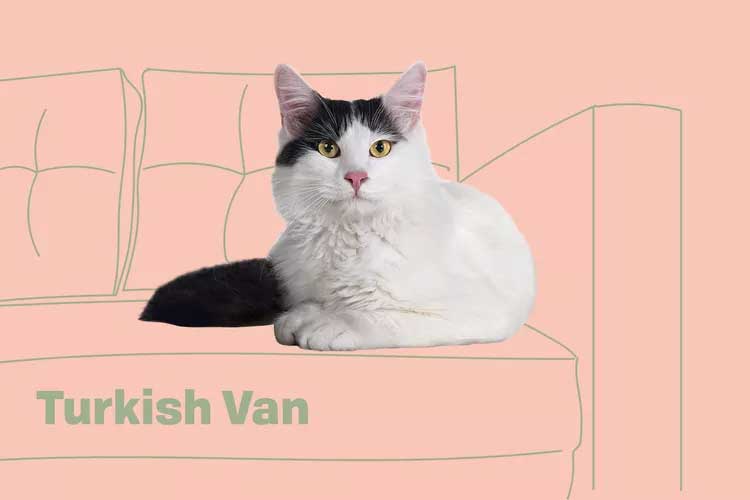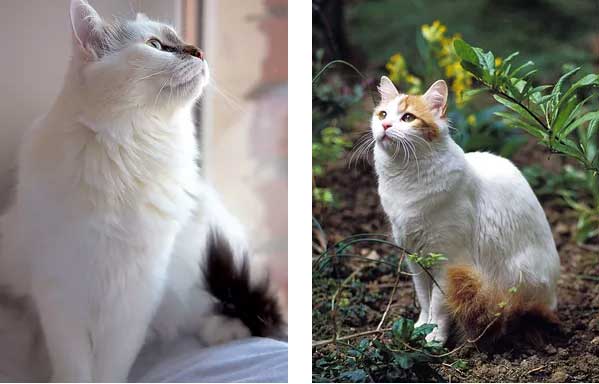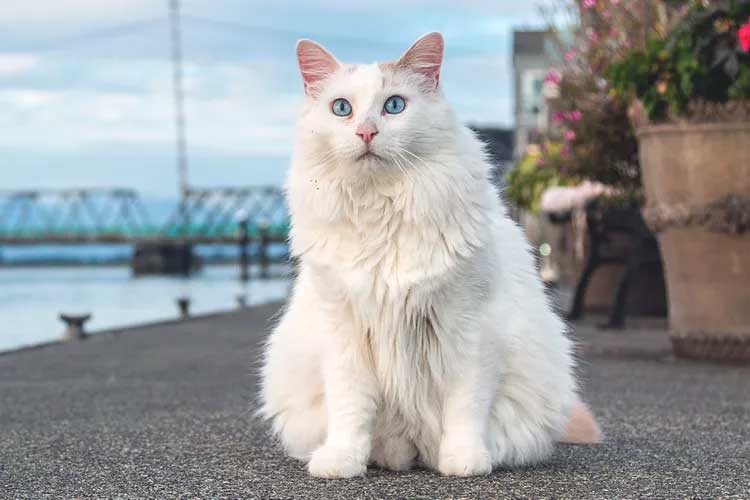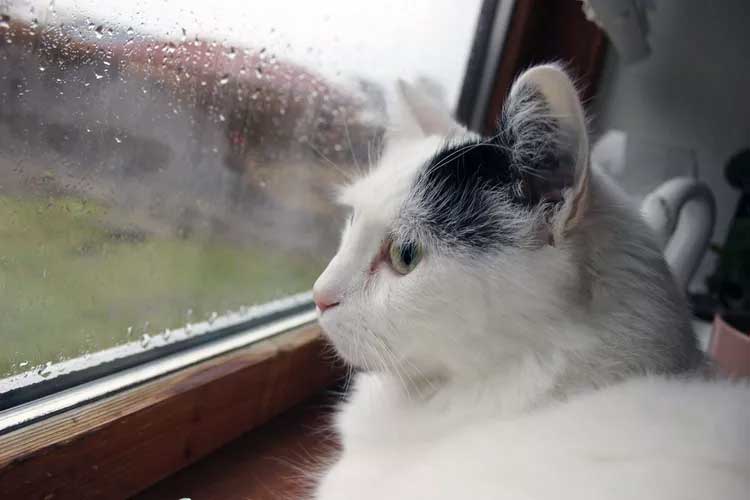An ancient, naturally occurring breed, Turkish vans are treasured in their home country and renowned for their large, strong bodies as well as their propensity to swim.

Turkish Van Overview
| OFFICIAL NAME | Turkish Van |
| COMMON NAME | Turkish Van |
| PET HEIGHT | 10 to 14 inches |
| PET WEIGHT | 10 to 20 pounds |
| LIFESPAN | 12 to 17 years |
| GOOD WITH | cats, children, families |
| TEMPERAMENT | sociable |
| INTELLIGENCE | high |
| SHEDDING AMOUNT | seasonal |
| PLAYFULNESS | high |
| ENERGY LEVEL | active |
| VOCAL LEVEL | when necessary |
| COAT LENGTH | long |
| COLORS | white |
| PATTERNS | bi-color |
| OTHER TRAITS | easy to train, friendly toward humans, tolerates being alone |
The Turkish van is a naturally occurring cat breed that originated in the mountains of Turkey. Not to be confused with Turkey's other cat export, the Turkish Angora (more on that later), the Turkish van is beloved by owners for his sturdy build, playful and active nature, and for being one of the relatively rare breeds of cat that has an affinity for water.
Appearance
While all-white Turkish vans do exist, they are not considered show quality and are therefore actively bred against. What gives the Turkish van his name is the "van pattern" of coloration: an all-white body, with different colored spots on their heads, and a usually solid-colored tail of the same shade, according to the breed standard.Interestingly, while it can be easy to look at the Turkish van and assume he's a white cat with splashes of color, genetically speaking, the exact opposite is true. A result of the piebald gene, the Turkish van's coloration is actually that of a red, cream, black, blue, or tabby cat with large spots of white covering their bodies. While this gene usually manifests in spotting or blotching of color (think black and white spotted horses or cows), in the Turkish van, the white manifests in a single, large "spot" that covers their torsos.

In addition to his distinct coloration, the Turkish van's coat is medium-long and single coated, making it cashmere-soft and easy to maintain, according to the Cat Fanciers' Association. It lies close to their bodies, giving the Turkish van a satin appearance, and their coats are surprisingly water-resistant, making them easy to dry off when they get wet, but difficult to bathe.
Underneath that coat, the Turkish van is an absolute unit. Male cats reaching 20 pounds are not uncommon, and the cats have been known to measure 3 feet from nose to tail tip. They are well-muscled cats, making them incredibly athletic, especially when it comes to jumping.
Their heads are slightly wedge-shaped, ears are of medium size and positioned just to the outside of the eye's centerlines, and the eyes themselves are mostly round and come in amber, blue, or a heterochromatic combination of both.
Temperament
Turkish vans are incredibly intelligent, easily trainable cats, says Marilyn Krieger, certified cat behavior consultant in San Francisco. They can be trained to do tricks like fetch toys fairly easily."Clicker training is a wonderful thing to do with them, as it is with all cats," Krieger says. "It also mentally stimulates them and it's fun, and it really helps them bond with their people. … You just need to know what really rocks their socks, what kinds of treats they adore. A treat does not have to be a food treat; a treat can be being petted or affection."
Remember when we said that the Turkish van was athletic? Yeah, please do not confuse that with thinking they are graceful. Furniture wobbles and rocks when he jumps, things will get knocked off ledges as he passes by, and each time he makes his way back down to the floor, you will definitely know it.

While Turkish vans are affectionate to their family members (Krieger says "they're definitely people cats"), these are not normally lap cats. They may lie next to you and will happily allow themselves to be petted, but this is not a breed that tolerates being picked up and often wants to be near you, not on you.
Finally, depending on individual temperament, Turkish vans have a reputation for being eager swimmers and water enthusiasts. Owners report finding their vans playing in toilets, turning on water faucets so they can drink and splash, and even going for short swims in pools or lakes.
Living Needs
Turkish vans do well in a single-pet household. When put in a home with other cats, they are fairly quick to accept the company. Dogs can be no problem, too, as long as they are introduced properly and patiently.When it comes to families, Turkish vans are happy to play with children, but care must be taken to make sure small ones are reminded how to interact with pets and to pay attention to the kitty's body language.

"They don't want to be picked up and held as a general rule," Krieger says. "That's kind of a Turkish van thing; they show their affection in other ways. So if they're with children, it's something important for kids to know."
Turkish vans are a social and smart breed, and they're not a cat you can leave alone all day long. If you have to leave them alone, you need to make sure they won't get separation anxiety.
"You need to have stuff for them, like interactive toys that they like," Krieger says. "You need to make sure you have that vertical territory [like cat trees] and scratchers and all those types of things for them. You might even want to have a pet camera so you can interact with them."
Care
Turkish vans are seasonal shedders, as their coat gets thicker over the winter months and thins out in the warmer months. But aside from seasonal changes, they are fairly easy cats to maintain, thanks to their lack of an undercoat.Brushing them with a slicker brush once a week should be plenty to keep them looking glossy and sharp. Baths shouldn't need to be a common occurrence, but when they are necessary, know that the Turkish van's naturally water-repellent coat can make it difficult to get them properly clean.
As with all cats, make sure to trim your Turkish van's nails, keep his litter box clean, and brush his teeth at home.
Health
As an extremely old, naturally occurring breed, the Turkish van is largely free of genetic issues and breed-specific health defects. Unlike the Turkish Angora, the Turkish van doesn't have issues with deafness.Keeping an eye on common feline issues as they age is a safe bet, and older cats may have to have their diets adjusted to keep them from falling into the trap of obesity.
Additionally, due to the Turkish van's larger size, you may want to talk to your vet about delaying any spay or neutering procedure, as an early adjustment to their hormone levels can affect how their bones and muscles grow.
"Sometimes these larger breeds are being spayed at four or five months of age because that's been the veterinary norm," says Carol Margolis, DVM, DACT, of the Gold Coast Center for Veterinary Care on Long Island, N.Y. "But I'm a reproductive specialist, so I'm a big fan of reproductive hormones. I'll let my larger breeds of cats go closer to 1 year of age [before spay or neutering] if we can."
History
The Turkish van has been around for centuries, naturally roaming the mountains in their homelands of modern-day Turkey. Specific breed origins are always difficult to track, but archeologists have found artwork and jewelry dating back at least 5,000 years that bears images of cats with remarkably similar body shapes and markings to the Turkish van, according to the Turkish Van Cat Club (TVCC).
The breed is genetically different from the Turkish Angora in a number of ways, the most noticeable of which is coat coloration. While Turkish Angoras are solid white cats, the Turkish van is actually a darker-colored cat with large white spots that cover almost their entire bodies.
The Turkish van began to gain notice outside of their native country when two British travel writers, Laura Lushington and Sonia Halliday, were given a pair of van cats as gifts while touring the country in 1954, according to the (TVCC). Surprised by how hardily the pair of cats handled the rigors of car travel and delighted by their penchant for swimming, Lushington and Halliday decided to bring the cats back home with them and began breeding the pair shortly thereafter.
Originally called the Turkish cat, the name was changed to Turkish van after receiving recognition by the Governing Council of the Cat Fancy (GCCF) in 1969, to help differentiate the breed from the Turkish Angora. Vans were brought to the United States in 1982 and accepted by the Cat Fanciers' Association in 1994.
Fun Facts
The Turkish van has existed within their home country for so long, there are folktales of the breed coming to Mt. Ariat on Noah's Ark.Many Turkish vans sport a small, colored marking between their shoulder blades. In their native Turkey, this is commonly referred to as the "thumbprint of Allah" and is said to be where Allah himself blessed the breed.
Still considered a national treasure, the Turkish van is now protected in their home country, and exports out of Turkey are tightly regulated.